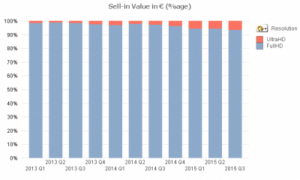Next week, I’ll be at ISE in Amsterdam. The show has been the main audio/visual show in Europe (and, arguably, the world) for several years and our team has covered every event since the first. I know that one of the questions that I will be asked, by clients of our market research services, will be about UltraHD panels in digital signage.

UltraHD in digital signage is an interesting question. On the one hand, it’s extremely clear that the TV market in larger sizes is becoming, almost purely, an UltraHD market at sizes of 55″ and above. That means that panel makers will be very comfortable about making panels of that resolution with high yields and great quality. So, surely panel makers will put pressure on to digital signage display makers to switch?
Actually, this is not as obvious as you might think. Let’s look at it from the point of view of the operator of the digital signage system. First, as has often been pointed out on Display Daily, resolution issues are very related to viewing distances. The reality is that most digital signage and professional large format display applications are designed to be used at distances of several metres. This means that the benefits of the higher resolution will be invisible to most viewers. Of course, there might be a small number of very high end retail applications, such as in fashion stores, where the high quality might be attractive.
Second, UltraHD is not without some penalties. Panel prices are still higher than for FullHD panels. However, price is not the only issue. By using smaller pixels and with more of them, the aperture ratio of the panel (the area of the panel that transmits rather than blocks the light from the backlight) goes down. That has one of two implications, neither of which is positive. Either the brightness goes down (for the same backlight power) or the power consumption goes up (for the same brightness). Power consumption and brightness are both significant factors in decisions about digital signage applications, so that’s a clear negative.
What is not always obvious to those starting in digital signage, especially those from the hardware side, is that one of the hardest issues in building successful networks is content creation, maintenance and distribution. Many early attempts to commercialise the digital signage application foundered because of the difficulty of keeping content fresh, although more recent developments in software and multimedia have made this less of a barrier. However, ensuring that content works equally well on FullHD and on UltraHD displays is another complication (as it’s unlikely that adopting UltraHD would mean a swap out of existing FullHD).
Further, the means of driving UltraHD displays may mean changes in media players or driving electronics. That raises the prospect of mixed inventories of players, which is a very negative point for those that own networks. It’s several years since I first heard a major network owner complaining about the huge variety of driving systems that it had to maintain for its various networks, but this is a real issue for network operators. (and standards such as OPS for UltraHD still need work – watch for news by DSE this year on this topic)
So, for reasons of content creation and testing, power and brightness and driving, UltraHD might be negative for digital signage applications.
 UltraHD Value Sales Development in Europe – Volume share is lower. Source: Meko Ltd
UltraHD Value Sales Development in Europe – Volume share is lower. Source: Meko Ltd
What About the Supply Side?
In the past, however, we have often seen the panel supply side of the industry drive technological change in order to achieve economies of scale, so won’t panel makers simply force the change? I don’t believe so. In recent years, panel makers have changed from a mentality of simply lower cost and higher volume towards a strategy of trying to maximise revenues. This reflects the reality that none of the major large area panel markets is growing in revenues and there is increasing competition from China in the volume categories. As a result, it is better for panel makers that make the special panels needed for 24/7 professional applications to keep them “special” and sold at a premium in smaller volume, than to try to switch them over to the mainstream formats of the TV market.
We have seen the same pattern in monitor panels. Many corporate users like 16:10 format displays for office applications and some even still like to buy 19″ 1280 x 1024 monitors. If the panel industry had been following the trend, seen up to three or four years ago, of seeking maximum volumes and cost efficiencies, those sizes of panels would have been killed long ago. However, they remain in production, as long as the buyers are willing to pay a premium for them.
The same will apply in digital signage. While the panel makers can get more revenue per square metre from the FullHD professional panels, than from TV panels, then they will remain available and all those user issues will win the day. At some point, UltraHD players, software and power performance will be the same or better than FullHD, but I still see that time as several years away, yet. BR

